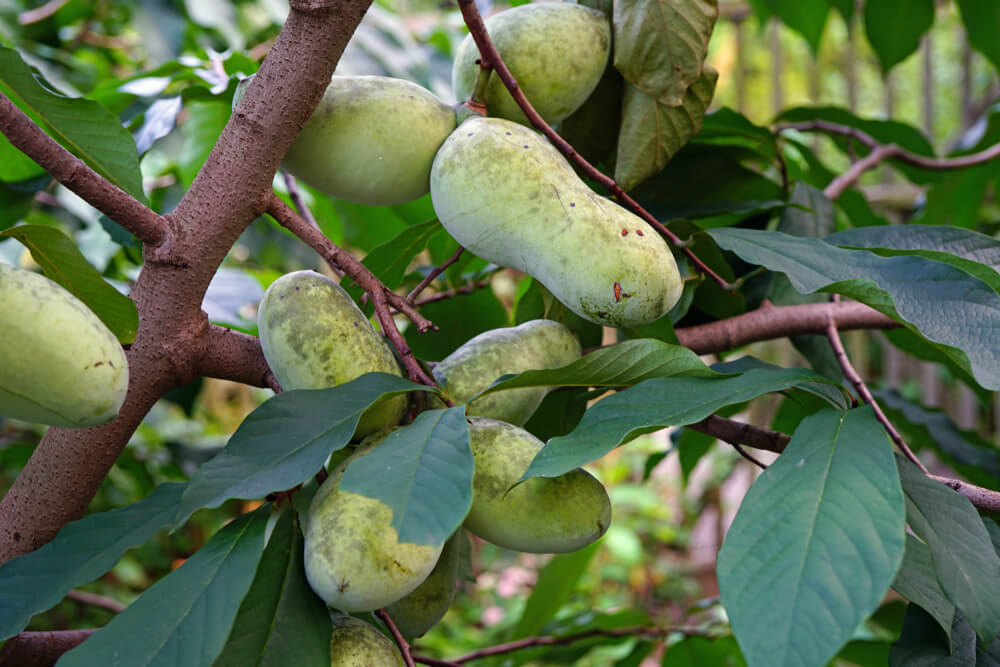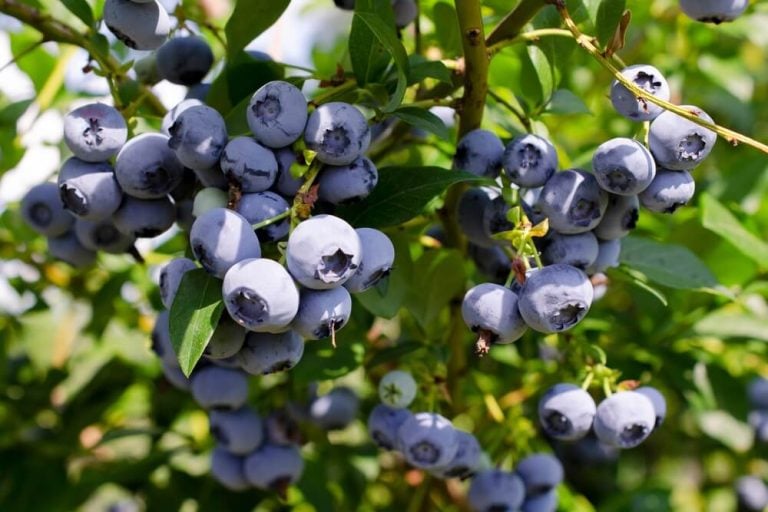The Ultimate Guide To Growing Pawpaw Trees – From Seed To Backyard Harvest!
Welcome! This article contains affiliate links, meaning I get a commission if you decide to make a purchase through my links, at no extra cost to you.
Want to grow some delicious fruit that tastes like a tropical vacation but thrives in cold climates? Meet the pawpaw! It’s North America’s largest native fruit with creamy, custard-like flesh. It tastes like a mashup of banana, mango, and melon. The best part? They’re low-maintenance once established, have virtually no serious pests, and can handle winters down to -20°F.
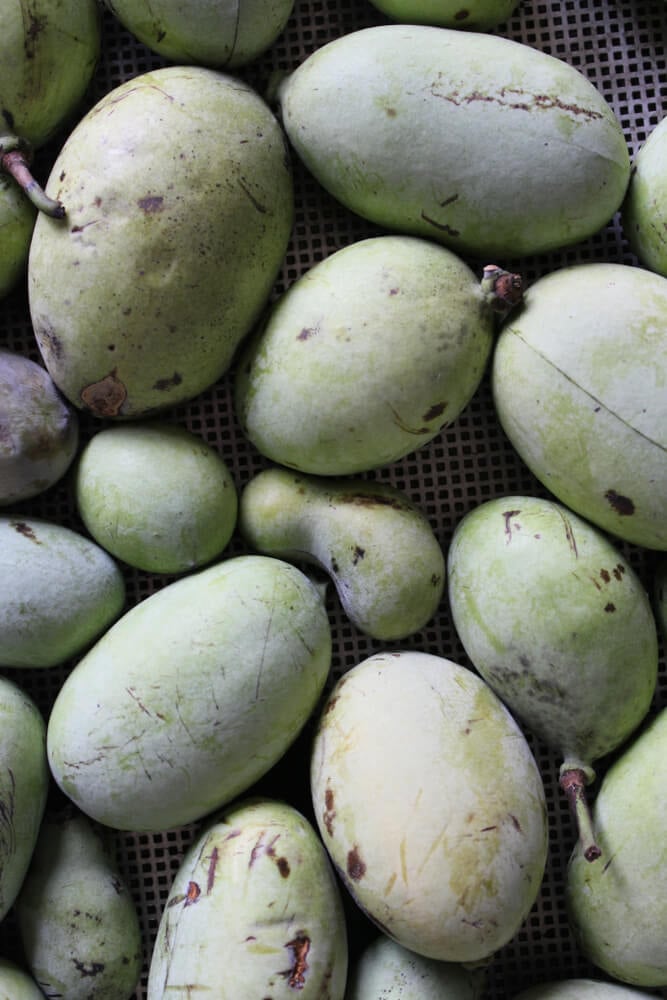
Here’s everything you need to know about growing them – from seed or transplant.
Growing Pawpaw Trees From Seed
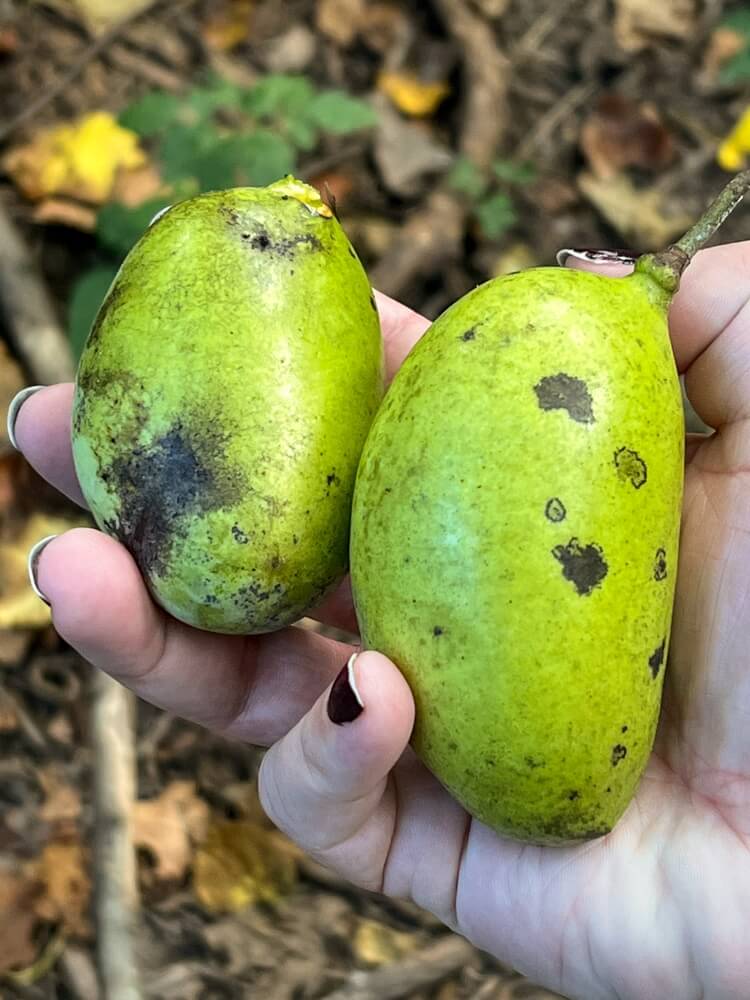
Sure, growing pawpaws from seed will test your patience (we’re talking 8 to 9 years before you see fruit), but hey, it’s practically free if you can snag some seeds from a friend or a farmers market! Just know that buying a baby pawpaw tree from a nursery will save you years of waiting. But if you’re in it for the journey and love a good garden project, let’s do this.
Step 1. Collect And Clean Your Seeds
The first thing you need is some fresh pawpaw seeds. These seeds fade fast, so they must be fresh. It’s best to harvest your pawpaw seeds in late summer or fall. Scoop out the seeds from a pawpaw fruit, rinse all the pulp, and then stand by for the next step.
Step 2. Stratify Your Pawpaw Seeds
Here’s the deal. Pawpaw seeds need cold stratification to germinate. In nature, they’d fall to the ground and chill through winter. You’re going to simulate that. Mix your seeds with slightly moist (not soggy!) sand or peat moss, seal them in a plastic bag. Then, stash your pawpaw seeds in your refrigerator for 90 to 120 days. Yeah, that’s 3 to 4 months. Mark your calendar!
Step 3. Plant With Care
After cold stratification, sow pawpaw plant seeds about 1 to 2 inches deep in pots with well-draining soil. Keep them warm (70 to 85°F is ideal) and moist. Be patient! Germination can take 3 to 8 weeks or even longer. These seeds are not in a hurry.
Step 4. Baby Those Seedlings
Once they sprout, pawpaw seedlings have varying sunlight demands. They actually prefer shade for their first year or two (just like in the wild, where they grow under the forest canopy). Give them filtered light and protect them from harsh afternoon sun. Keep the soil moist but not waterlogged.
Step 5. Transplant Carefully (When They’re Ready)
After 1 to 2 years of growth, your seedlings should be sturdy enough to plant outside. Here’s the tricky part – pawpaws have deep taproots and hate being transplanted. Disturb those roots as little as possible. Spring is your best transplanting window.
Read More – How To Grow Blueberry Shrubs At Home From Seeds, Cuttings, Or Seedlings – The Ultimate Guide!
Growing Pawpaw Trees From Seedlings Or Transplants
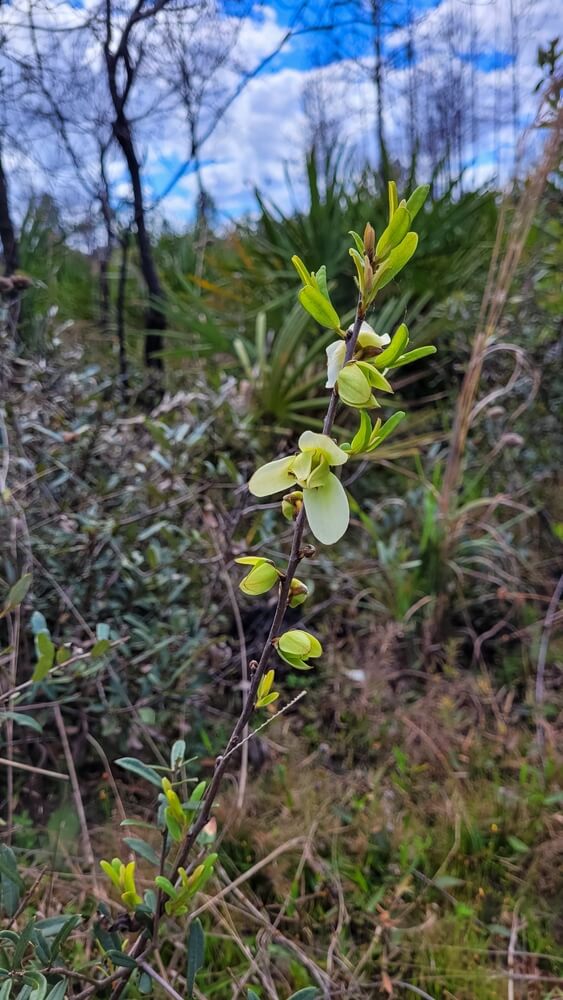
Obtaining a pawpaw tree seedling from your favorite plant nursery is the superior and faster method. You’ll harvest yummy pawpaw fruit much sooner this way, in about three to five years. Plus, no stratification fuss! (Getting a grafted pawpaw tree also helps guarantee that you’ll get the exact fruit variety you want, which can be dicey when growing seeds.)
Step 1. Choose Your Pawpaw Wisely
Buy from a reputable nursery that specializes in native plants or fruit trees. Look for healthy specimens that are 1 to 3 feet tall.
Opt for grafted varieties for cultivars like Shenandoah, Susquehanna, or Mango. These are proven pawpaw winners with superior fruit. Buy at least two different varieties for cross-pollination. Otherwise, you’ll be waiting forever for fruit!
Step 2. Prep Your Planting Site Like You Mean It
Pawpaws love rich, slightly acidic soil (pH 5.5 to 7) with good drainage. Pick a spot for your pawpaw with full sun to partial shade (they can handle more sun once established, but appreciate afternoon shade in hot climates). Dig a hole roughly two or three times wider than the pawpaw’s root ball but no deeper. You want the tree to be at the same depth as it was growing in the pot.
Step 3. Plant With Minimal Root Disturbance
Pawpaws have sensitive taproots. Gently remove the tree from its container, keeping the root ball as intact as possible. Don’t tease out the roots like you might with other plants! Gently place it in the hole, backfill with your amended soil, and water deeply. Add a 3 to 4 inch layer of mulch around the base (but keep it away from the pawpaw’s trunk) to retain moisture and suppress weeds.
Step 4. Water, Protect, And Be Patient
Keep your newly planted pawpaw consistently moist (but not soggy) for the first year. They’re working hard to establish those deep roots. If you planted in a sunny spot, consider using shade cloth for the first summer to prevent leaf scorch. Water your baby pawpaw once or twice weekly and watch your investment grow into a fruit-producing powerhouse!
Read More – 21 Low-Maintenance Xeriscaping Plants For Stunning, Water-Wise Gardens!
Pawpaw Tree Growing Requirements
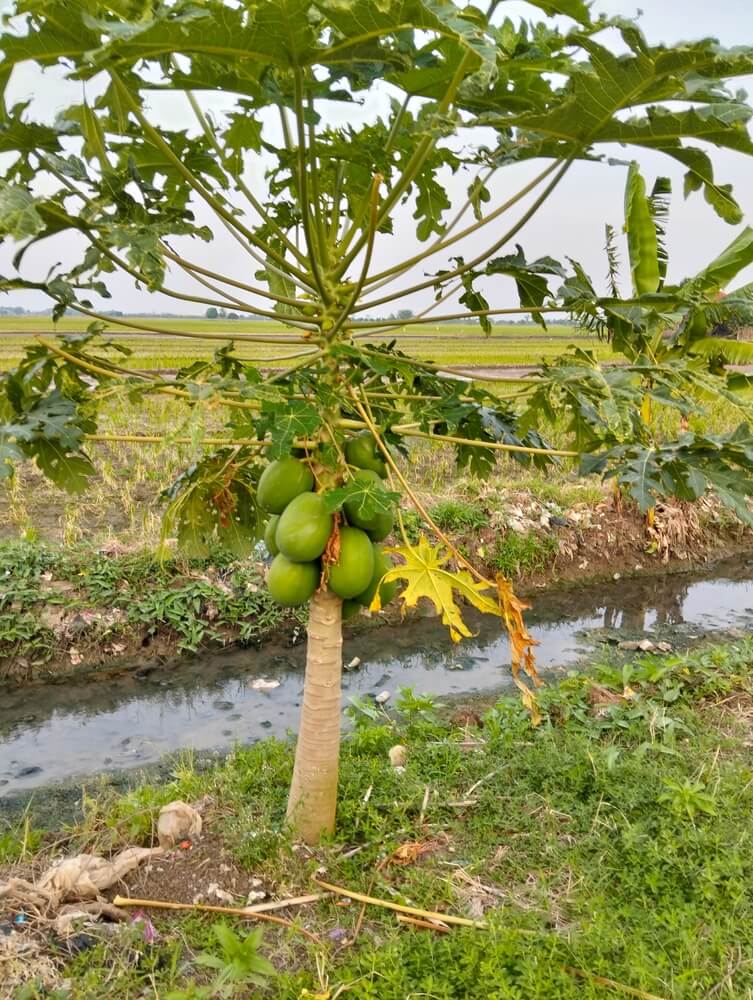
Alright! You’ve got your pawpaw tree safely in the ground! Now we have to carefully analyze the best care tips so you can produce buckets of delicious pawpaw fruit without second-guessing.
Sunlight
Pawpaws are contradictory when it comes to the sun. When they’re young (first 2 to 3 years), they’re shade lovers. This is when they want dappled woodland light, just like they’d get growing under the forest canopy in the wild. But once they mature? They want full sun to produce the best fruit, which means 6 to 8 hours of direct sunlight daily.
So plant them where they’ll eventually get good light, or be prepared to prune surrounding trees as your pawpaw grows up. (Planting your pawpaw where it gets morning sun + afternoon shade can be a great place – especially if you live in a hot USDA grow zone.)
Climate
Pawpaws are tougher than they look! These native North American trees handle cold like champs. They’re hardy in USDA zones 5 to 9 and survive winter temperatures down to -20°F once established. They also require a reasonable chill period (around 400 hours below 45°F) to set fruit properly. So, they are one of the few fruit trees that love cooler weather rather than tropical! The sweet spot? Anywhere with cold winters and warm, humid summers. Think of the Eastern and Midwestern United States.
Soil + Fertilizer
Pawpaws thrive in deep, fertile, well-draining soil rich in organic matter, like river bottomland conditions. The ideal pH for pawpaws is mildly acidic to neutral (5.5 to 7.0). They absolutely love soil loaded with compost and leaf mold. What don’t they love? Heavy clay that stays waterlogged. Or sandy, fast-drying soil with lackluster nutrients.
Pawpaws aren’t heavy feeders once they establish themselves. But they appreciate a spring application of balanced organic fertilizer (like 10-10-10) or a layer of compost mulch. Their deep taproots (which can reach 3 to 5 feet down!) access nutrients deeper than most fruit trees.
Pollination
Here comes a tricky part. Pawpaws have perfect flowers (meaning each flower has both male and female parts). But they’re self-incompatible. In other words, a tree can’t pollinate itself. You need at least two genetically different pawpaw trees for cross-pollination and fruit set. Even better? Plant three or more varieties to maximize your chances.
Pawpaws are pollinated primarily by flies and beetles, not bees. Their dark maroon flowers bloom in early spring and have a potent, yet unusual, earthy scent that attracts these pollinators. In some gardens, especially new plantings, natural pollination can be spotty.
Watering
Pawpaws prefer moist soil, like a forest floor after rain. They need about 1 or 2 inches of water per week, either from rainfall or irrigation. Young trees, especially, need regular watering while establishing those deep taproots. Don’t let them dry out during their first year or two!
Once mature, pawpaws are reasonably drought-tolerant thanks to those deep roots. But fruit quality suffers if the plants are stressed during the growing season. Water deeply rather than frequently. You want that moisture to reach down and encourage strong root development. Drip irrigation or soaker hoses work beautifully.
Harvesting
Here’s how you know they’re ready to pick and eat. The pawpaw fruit will soften slightly and may drop from the tree on its own. In fact, some folks spread tarps under their trees to catch falling fruit. Ripe pawpaws give gently to pressure (like a ripe avocado) and develop a more pronounced fruity aroma. The skin may change from green to slightly yellowish or create brown spots.
Don’t wait for them to turn completely soft on the tree: pick them when they’re just starting to yield to gentle pressure. They’ll continue ripening off the tree and taste incredible within a few days. Handle them carefully. They bruise easily! Fresh pawpaws only last two to three days at room temperature, or about a week in the fridge. For more extended storage, scoop out the pulp, remove the seeds, and then freeze the pulp. The pulp freezes beautifully and works great for smoothies, ice cream, or baking later.
Taste-test as you go. Different varieties ripen at other times, and in your first harvest year, you’ll want to learn exactly when your trees produce the best-tasting fruit. Some gardeners prefer them slightly firmer, others wait until they’re custard-soft. Happy harvesting!
Read More – How To Grow Gorgeous Japanese Maple Trees From Seed In Your Home Garden – The Ultimate Guide!
Pawpaw Planting And Growing Schedule
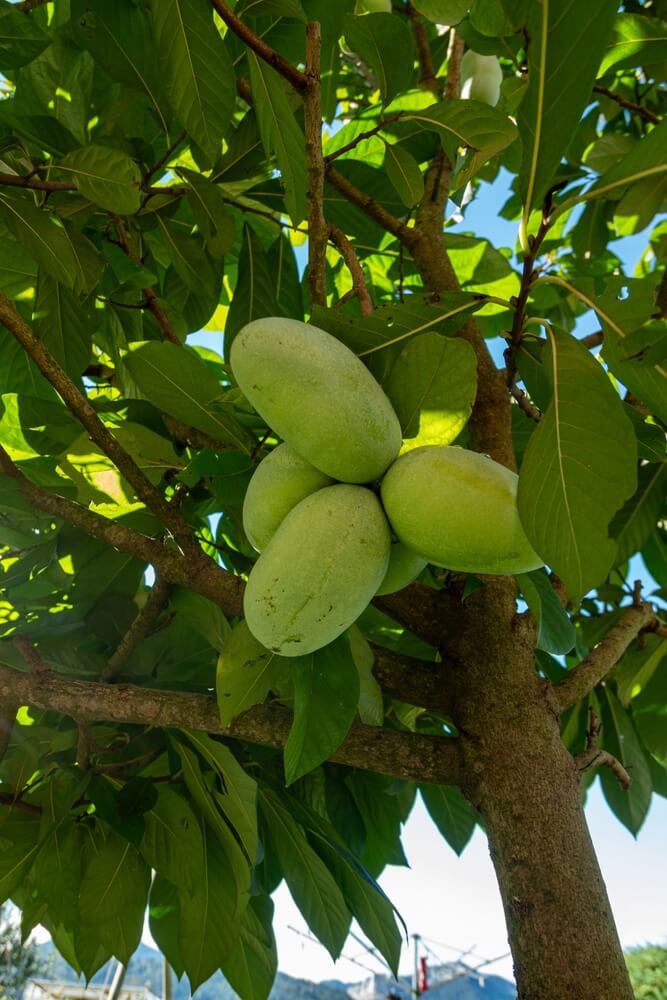
Here are the critical dates all pawpaw growers should know.
April
April is prime planting time for bare-root or potted pawpaw trees! The soil is warming up, but trees aren’t stressed by summer heat yet. You’ll also see those curious dark maroon flowers blooming on mature trees. If you want to guarantee fruit, now’s the time to hand-pollinate with a small brush on warm, sunny mornings. Keep young transplants shaded and consistently watered as they settle in.
May
Your pawpaws are leafing out and growing actively now. Mulch around the base with 3 to 4 inches of organic material to conserve the pawpaw tree’s moisture and suppress weeds. Also, try keeping the mulch a few inches away from the trunk. Watch for any late frost warnings! While established trees are tough, late freezes can damage developing fruit.
June
Summer growth is in full swing! Make sure your trees get consistent water, about 1 or 2 inches per week, especially if rain is scarce. Young trees still need protection from intense afternoon sun, so check that shade cloth or natural shade is doing its job. You might notice small green fruits developing on mature trees.
July
Continue regular watering as temperatures peak. Deep soaking once or twice a week is better than frequent shallow watering. If you’re in a particularly hot region, your trees will appreciate some afternoon shade. Otherwise, maintain that mulch layer and let them do their thing.
August
Harvest season begins! Early varieties are now starting to ripen. You’ll notice pawpaw fruits softening and possibly dropping from the tree. Check your pawpaw trees every few days. The fruits ripen quickly once they start. Gently squeeze fruits still on the tree. If they yield slightly to pressure, they’re ready to pick. The aroma intensifies when they’re ripe, too. Continue watering regularly. Don’t let up just because harvest has started.
September
Peak pawpaw season is here! Most varieties ripen in September, and you should be checking your trees daily for ripe fruit. Consider spreading a tarp or old sheet under the tree to catch any that drop overnight. Eat them fresh, share with amazed friends and neighbors, or freeze the pulp for later. As the month progresses and harvest winds down, you can start reducing watering frequency as temperatures cool.
October – Winter
Late varieties finish ripening in early October, then it’s time to let your trees rest. Once leaves drop, apply a fresh layer of mulch around the base for winter protection. This protective mulch layer is essential for younger trees. No fertilizing or pruning needed now. Pawpaws prefer minimal pruning anyway. If you’re planning to grow from seed, collect fresh seeds from ripe fruits now and get them stratifying in the fridge for 90-120 days.
Read More – 15 Gorgeous Rose Cultivars That Bloom Well Into The Fall And Autumn!
5 Best Pawpaw Tree Cultivars
These are our five favorite pawpaw tree cultivars we recommend for home growers!
Overleese
Overleese is easily one of the most celebrated pawpaw varieties. It produces large, creamy fruits with exceptional flavor. It tastes like a tropical custard with hints of banana and mango. The fruits are plump and heavy, often weighing 8-16 ounces each. They sport smooth, greenish-yellow skin when ripe. This Indiana heirloom has been a favorite since the 1950s and consistently delivers reliable crops with minimal fuss.
- USDA Growing Zones: 5 through 8.
- Harvest Season: Mid-season.
- Yield: High.
- Best Way To Eat: Versatile, great fresh, in ice cream, or for baking into breads and desserts.
Overleese pawpaws are perfect if you want a reliable, proven performer with outstanding fruit quality.
Shenandoah
Shenandoah is a commercial grower’s dream. This yummy cultivar produces beautifully uniform fruits with rich, sweet flesh and relatively few seeds. The fruits are medium to large with excellent shelf life (for a pawpaw, anyway), making them ideal if you’re hoping to share your harvest or even sell at farmers’ markets. The flavor is complex and balanced, featuring creamy notes with pronounced tropical undertones that are not overpowering.
- USDA Growing Zones: 5 through 8.
- Harvest Season: Mid-season.
- Yield: High.
- Best Way To Eat: Fresh eating, smoothies, or frozen for later use.
If you want a pawpaw that impresses both in flavor and appearance, Shenandoah delivers every time.
Susquehanna
This variety produces truly massive fruits. We’re talking some of the largest pawpaws you’ll ever see, often exceeding one pound each! Susquehanna has a loyal following thanks to its rich, sweet flavor and thick, custardy texture. The fruits have bright yellow flesh that’s incredibly aromatic when ripe, and the tree itself is a vigorous grower.
- USDA Growing Zones: 5 through 8.
- Harvest Season: Mid to late-season.
- Yield: Medium to high.
- Best Way To Eat: Fresh is best to appreciate that luxurious texture, but it is also excellent for ice cream.
Plant Susquehanna if you want bragging rights for the biggest pawpaws on the block.
Mango
Don’t let the name fool you. This is 100% pawpaw, but with a flavor profile that leans distinctly tropical and, yes, mango-esque. Mango produces medium-sized fruits with smooth, fiberless flesh that’s incredibly sweet and aromatic. The tree is a consistent producer, and the fruits ripen with beautiful golden-orange flesh that looks as good as it tastes.
- USDA Growing Zones: 5 through 8.
- Harvest Season: Early to mid-season.
- Yield: High.
- Best Way To Eat: Enjoy fresh eating to showcase that distinctive tropical flavor, or blend it into smoothies.
If you’re looking for a pawpaw that truly delivers on that “tropical fruit of the North” promise, Mango is your tree.
Wabash
Wabash is another Indiana native that produces consistently large crops of high-quality fruit with excellent flavor and minimal seeds. The fruits are medium to large with deep yellow flesh that’s sweet, creamy, and wonderfully aromatic. This variety is known for its cold hardiness and reliable production, making it a solid choice for northern growers.
- USDA Growing Zones: 4 through 8.
- Harvest Season: Mid-season.
- Yield: High.
- Best Way To Eat: Versatile, excellent for fresh eating, baking, or making pawpaw butter and preserves.
Wabash is the dependable workhorse that won’t let you down, year after year.
Read More – How To Grow Epic Fig Trees From Seeds Or Cuttings – The Ultimate Guide!
Common Issues With Homegrown Pawpaw
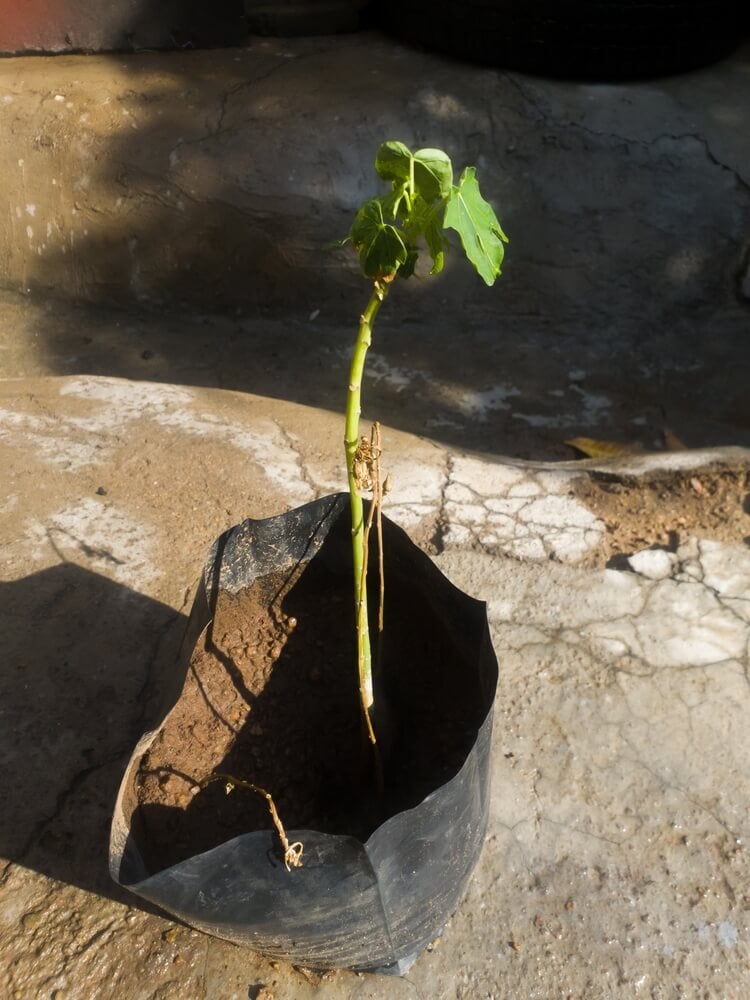
Even the most dedicated pawpaw grower will hit a few bumps along the way. Here are the top three problems home growers most often face when cultivating pawpaw trees (Asimina triloba), along with practical solutions to get you back on track.
1. Poor Pollination And No Fruit Set
This is the #1 complaint from pawpaw growers. “My tree bloomed like crazy, but I got zero fruit!” Pawpaw flowers aren’t pollinated by honeybees like most fruit trees. Instead, they rely on flies and beetles attracted to their faintly rotten-meat scent. In many suburban gardens, these pollinators aren’t around in sufficient numbers, especially if you have just one or two young trees.
Luckily, the fix is a piece of cake.
Plant at least two genetically different cultivars (not just two seedlings from the same parent) within 50 feet of each other for proper cross-pollination.
Hand-pollinate for guaranteed results. Use a small, soft paintbrush or cotton swab to transfer pollen from the flowers of one tree to another on warm mornings when flowers are fully open. It takes just minutes and dramatically improves fruit set.
Attract natural pollinators by hanging overripe fruit, banana peels, or even small pieces of raw meat near the trees during bloom time (yes, really, it works!). (Be mindful that this could also attract other animals.)
Be patient. Young trees under 5-6 years old often don’t pollinate well, even when all other conditions are perfect.
2. Transplant Shock And Sun Scorch On Young Trees
Pawpaws have deep, sensitive taproots that are extremely sensitive to disturbance. So they are surprisingly notorious for transplant shock. Young trees are also shade-loving in their early years, and planting them in full sun can cause severe leaf scorch, stunted growth, or even death. Many new growers lose trees in the first year simply from transplanting carelessly or exposing tender seedlings to harsh sunlight.
Fixing it is easy.
Transplant only when dormant (early spring or late fall) and handle the root ball like it’s made of glass. Keep it intact and don’t tease out the roots.
For the first 1 to 2 years, provide 30-50% shade using shade cloth, plant them under the dappled light of taller trees, or position them where they get morning sun and afternoon shade.
Start seedlings in deep pots (at least 12 inches) to accommodate that taproot, and transplant them when they’re still young and adaptable (1-2 feet tall is ideal).
Gradually acclimate young trees to more sunlight as they mature. By year three, they should be able to handle full sun and will actually need it for good fruit production.
3. Premature Fruit Drop And Pest Damage
You finally got fruit to set, and then… they drop off the tree when they’re still tiny and green. Heartbreaking! Premature fruit drop usually happens when trees experience inconsistent watering, nutrient deficiencies, or extreme heat stress. Additionally, while pawpaws have few pests, the pawpaw peduncle borer (a moth larva) can tunnel into fruit stems, causing drop, and zebra swallowtail caterpillars occasionally munch on leaves (though they rarely cause severe damage).
Fixing it is easy.
Maintain consistent soil moisture for your pawpaws throughout the growing season. Drought stress during fruit development is the main culprit for fruit drop. Deep watering once or twice a week is better than frequent shallow watering.
Apply a thick layer of organic mulch (3 to 4 inches) around the base to keep moisture levels even and soil temperatures stable.
Feed trees in early spring with balanced organic fertilizer or compost. Underfed trees often can’t support a whole crop to maturity.
Inspect developing fruit regularly for signs of borers (look for entry holes or frass on stems). If you find affected fruit, remove and destroy it to prevent the pest from spreading.
Please don’t panic about a few zebra swallowtail caterpillars. They’re beautiful, native butterflies and rarely cause severe damage. If they become a real problem, hand-pick them off.
Read More – 18 Delicious Edible Groundcover Crops That Are Way More Beneficial Than Turfgrass!
Conclusion
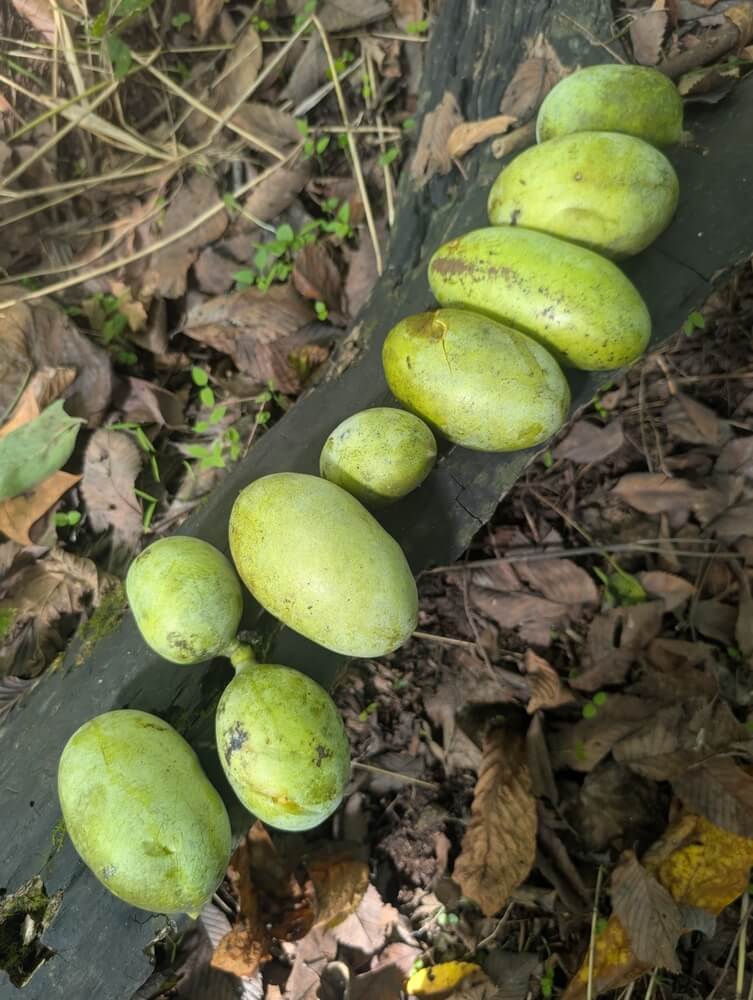
Yes, these trees march to their own drum with their finicky pollination, shade-loving youth, and those sensitive taproots. But once you understand what pawpaws need, they’re surprisingly forgiving and incredibly rewarding.
What about you?
- Will you grow some yummy pawpaw trees this year?
- Which pawpaw cultivar will you grow?
- Will you grow a handful of varieties? It will help with pollination!
Thanks for reading.
Have a great day!

